|
:: ::
| I Viaggi Del Gusto UNDER THE TUSCAN SUN |
|
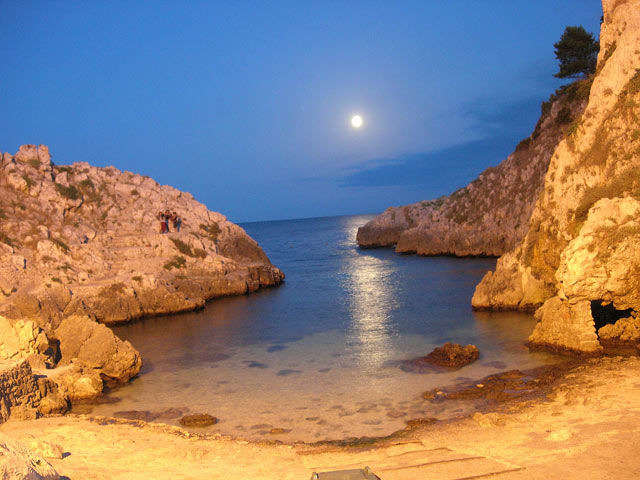 PUGLIA HIGHLIGHTS PUGLIA HIGHLIGHTS
- LECCE AND GALLIPOLI: THE BAROQUE IN APULIA
- THE BEAUTY OF TREMITI ISLANDS GARGANO
- FARMS AND TRULLI CASTLES OF ARAGONESE
- THE CAVES OF CASTELLANAE GALLIPOLI
- FOOD AND WINE ROAD
|
LIST OF PRIVATE GUIDED TOURS : APULIA AS YOU WANT
|
|
|
PUGLIA THE DOOR OF MEDDLE WEST BETWEEN PLATEAU AND FOR Taste of Slow
Do you like traveling because discover the past, local traditions is a richness ?
You love to have authentic experiences to abandon the contemporary frenzy and you are looking for a slow time to live the moment without tourist eyes
.. FOLLOW YOUR INSTINCT AND WE GUIDE YOU IN THE EXPERIENCE, THE ONE YOU CANNOT LIVE !!!
|
CONTACT OUR EMOTIONS' SAILOR
|
VISIT PUGLIA
|
|
_________________
VISIT PUGLIA
_________________
PUGLIA
EXPERIENCES
APULIA: PASSIONS LAND AND REBEL SPIRITS [......]
_________________
|
|
MAIN CITIES
BARI THE CAPITAL
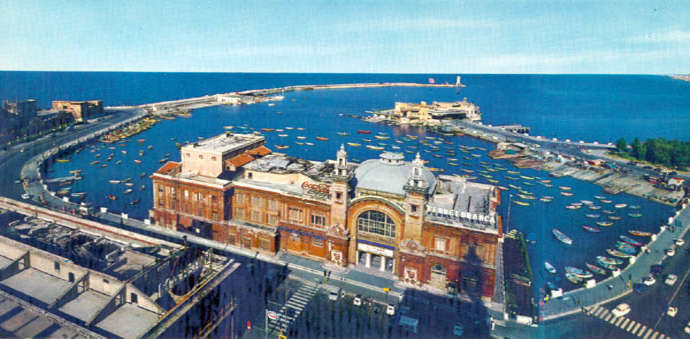
Between the Adriatic sea and the Ofanto, in a large quadrilateral area included between the territories of Daunia and Salento’s soglia messapica, the Land of Bari is composed of a series of steps which in time have created the Murge and the gentle slopes leading to the sea. Bari and its province developed thanks to the resources coming from the Adriatic sea, through trade and the relations to the Eastern Mediterranean, and from the hills characterising the karst territory thanks to agriculture and cattle breeding. The territory still maintains the signs of the activities of human beings and time: in the whole plateau, not exceeding 700 metres of altitude, kilometres of dry walls mark the boundaries of private estates interspersed with trulli, wonderful Romanesque cathedrals which have reached their highest development here, and the beautiful castles, in particular those of the time of Frederick II. Mention must be made of the National Park of Alta Murgia
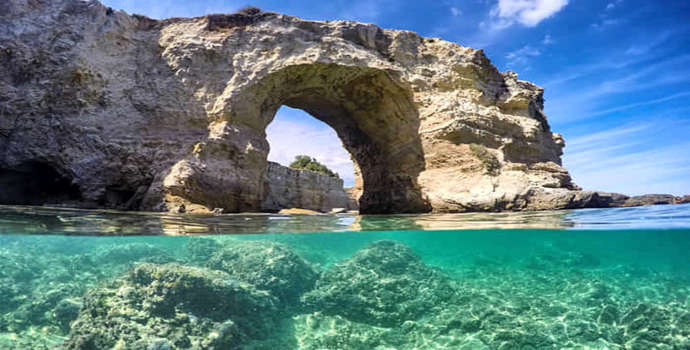
The Adriatic Coast of Bari territory is characterized by several cities overlooking the coast with their medieval centers. Apulian capital stands ashore with its Castle, close to smaller cities which allow spending beautiful, relaxing vacations at close touch with history.
Northern Murge are characterized by evocative Medieval towns, small fortified villages where that defended populations during invasions. Andria is famous for Castel del Monte, with its classical octagonal layout, built by Frederick II as hunting manor. Altamura makes a bread that puts together the fragrance of wheat and color of the Apulian sun
FOGGIA AND IMPERIAL PUGLIA
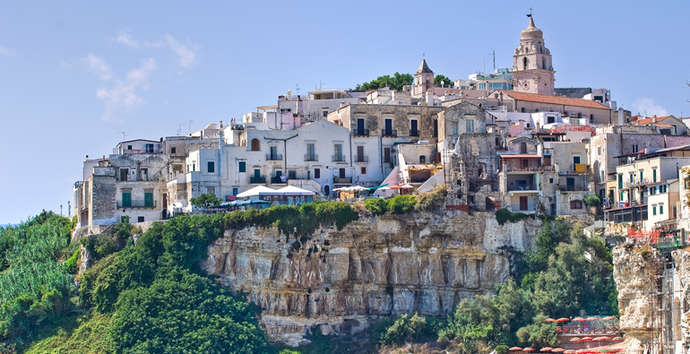
Imperial Puglia indicates the geographical area including the municipalities of Andria, Barletta, Bisceglie, Canosa di Puglia, Corato, Margherita di Savoia, Minervino Murge, San Ferdinando di Puglia, Spinazzola, Trani, Trinitapoli and is located between the provinces of Foggia and Bari. The project called “Puglia imperiale” stems from the need for promoting the history of those eleven municipalities and unite them under the auspices of the impressive Castel del Monte, which was awarded the status of heritage of mankind by UNESCO and acknowledged as the expression of the creative genius of Frederick II, who lived in this land for long periods.
One can either cross this territory along the coast exceeding 40 km or over the Murge plateau, which reaches 600 metres above the sea level, up to the Adriatic sea, but the feeling remains of going through its very ancient history rich in tokens, cathedrals, castles and a wonderful countryside.
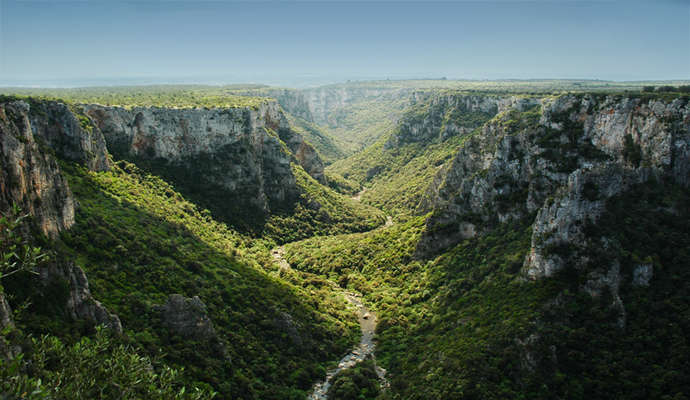
LE MURGE Follow Frederick II’s steps among charming medieval villages and castles. However, the history of this land dates back to a more distant past. The megalithic underground structures of Trinitapoli and San Ferdinando, or the dolmens of Bisceglie and Corato are tokens of archaic civilisations and Canosa, the main city of the region during the Imperial age, maintains the beauty of a glorious past which can be still be traced today
LA VALLE DELL'OFANTO Civilisation developed along the only river of Puglia. The first tokens date back to the bronze age, followed by the archaic Greek and Latin settlements, until the Romanesque period. The presence of Frederick II is witnessed everywhere, and in the 16th century Barletta saw the emergence of national pride through the victory over the French knights during the famous "challenge
LE COSTE FEDERICIANE Barletta, Trani, Bisceglie were important landing sites during the journey to the Holy Land and still host ancient towers to monitor a rich a fruitful coast. The coast of Imperial Puglia exceeds 40 km in length and is characterised by very interesting swamps in terms of the passage of dozens of thousands of migrating birds spending the Winter near the famous Salt works of Margherita di Savoia
TARANTO TOWN WITH TWO SEAS
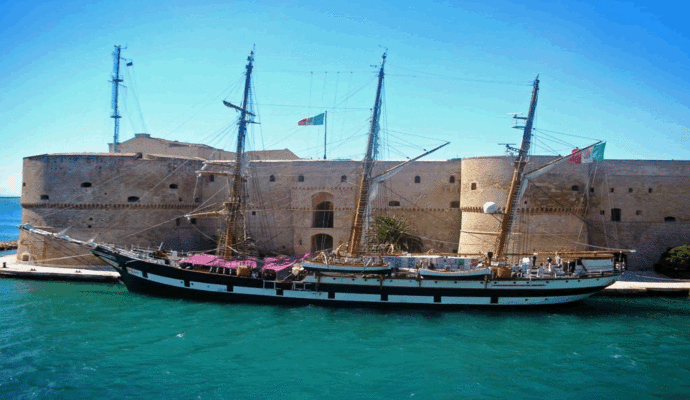
Taranto and its province have their most ancient roots in rock settlements and Greek culture. Two civilizations which developed well in this area of Southern Apulia thanks the conformation of a land once rich in water and very fertile, so much that Greek settlers were attracted by it and founded Taranto in 706 b.C. The presence of water courses, now flowing underground, is also witnessed by the several caves and creeks one can see in this area. A result of erosion, they are an ideal scenario for the development of those rock-settlement civilizations that spread over the whole region and particularly in Taranto area. Today, this province show a slightly sharper aspect in its inland, sandy sea beds and limpid sea in Taranto Gulf area. Ancient civilizations are still visible in the charm of wonderful landscapes included in natural settings.
In Taranto province inland area, characterized by a green landscape, olive groves and vineyards, there are several small towns like Manduria or Grottaglie, which roots can be found in ancient Messapi civilization. These towns often offer very interesting archeological and naturalistic parks.
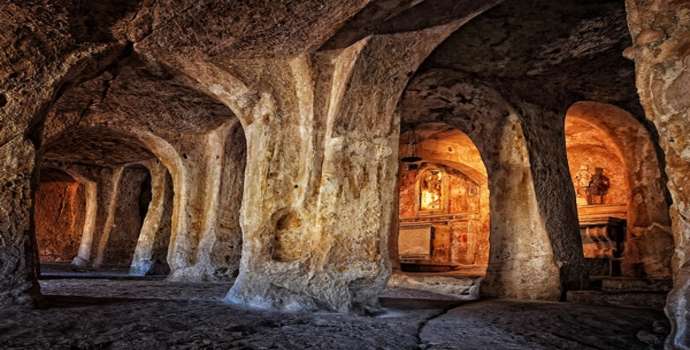
MURGE TARANTINE In Taranto Murge there are deep ravines resulting from the action of ancient rivers as well as several karstic caves where a flourishing rock-settlement civilization rose since prehistory. Often a haven for shepherds and peasants, these same caves were used in Middle Ages as a place of worship by Basilian monks. Traces and witnesses of rock settlements, hypogeous hamlets and frescoed walls can be seen near Mottola and Massafra
COSTIERA IONICA The Ionian coast is characterized by wide beaches and a limpid water sloping gently into deepness. Cities such as Taranto, also known as the "city of two seas" stand over this coast, and Pulsano with their tourist vocation and famous local food
BRINDISI AND ITRIA VALLEY

In Brindisi province, stones and buildings tell the story of this land. Appia and Traiana roads once connecting the city to Rome left their traces on modern roads. In this city, where Virgil died, there are the remains of two II –century columns that marked the end of Appia road.
The Norman – Swabian and Angevin marks also prevails in the inland area of province and former Messapi land, while it is even more evident in Mesagne, Oria and Ceglie Messàpica castles. In this area, natural landscape is characterized by ravines and caves shaped through centuries by the patient work of rivers. Rock witnesses of basilian monk civilizations can be found near Ostuni. Watch towers north of Brindisi tell the story of pirate and Saracen invasions, while the remains of ancient Egnazia Roman city can be seen in the respective archeological site.

LA VALLE D'ITRIA Itria valley is characterized by a flourishing vegetation where olive trees stand, These are cultivated in masserie lands, small typical local stone fortresses. Coasts are marked by long, sandy beaches, dunes and protected natural reserves. There are several traces of old Messapi civilizations, rock settlements, castles and not-to-be-missed trulloes made with drystone techniques.
TERRA DEI MESSAPI A proud, extremely loyal civilization, between the IX and VII centuries b.C. the Messapis built several settlements that were fortified with huge walls. Oria, with its characteristic castle, and Mesagne still keep witnesses that allow to reconstruct history, customs and habits of this ancient population.
LA COSTA BRINDISINA The coast of Brindisi area is characterized by small cities gathering around their historical centers, overlooking white beaches and crystal-clear waters. Brindisi is an example, with its huge castle emerging from the sea; Carovigno, dominated by Torre Guaceto and Ostuni, the white Mediterranean sea surrounded by olive trees and by a wonderful beach that hosts an unforgettable medieval center
LECCE AND SALENTO COSTLINE
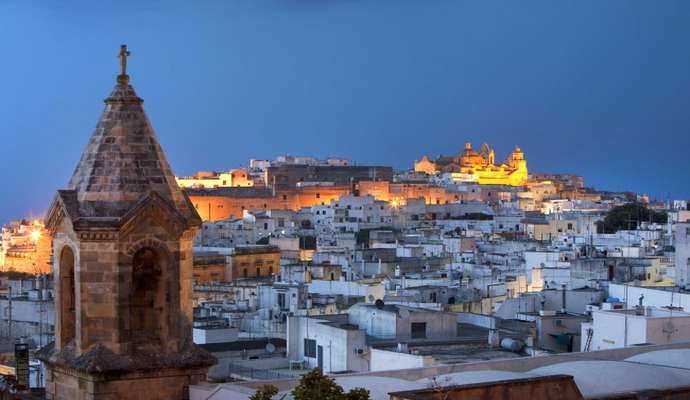
Baroque style affirmed in Apulia during Counter-Reformation upon the will of Roman Church. A way of exalting Catholic symbols, Lecce and Nardò Baroque has its own characteristics that make it different from the same artistic style in other regions. Its peculiarities derive from the use of amber-colored Lecce stone as well as decorations used to mask the structures on which they are mounted.
Sun, sea, wind. Nature strikes in the first place, when one gets to this land stretch in balance between two seas. Salento has its core in the province of Lecce, - a Baroque Florence in Southern Italy – and reaches the provinces of Brindisi over the Adriatic Sea, and Taranto on the Ionian Sea side. The cities and inland towns expressions of the unique Lecce Baroque with Messapi and Salento Grecìa can still be seen. Its language, songs and feasts still show the culture of Graecia Magna. Surf, kite-surf and windsurf lovers never miss the beaches facing the Alimini lakes, while scuba diving fans just have to choose among the several equipped centers and charming sea beds of the Ionian coast as well as of the area between Otranto and Santa Maria di Leuca.

LA COSTA DEL SALENTO Salento coast is characterized by a high variety in landscapes: the clear, fine sand beaches of Santa Cesarea seafront; famous caves such as Castro cave with its Grotta Romanelli, one of the most important Italian prehistoric settlements, and Grotta Zinzulusa, 'the pearl of caves', owing its name to the dialect word 'zinzuli', ('rags'), used by fishermen to indicate its beautiful stalactites and stalagmites
GRECIA SALENTINA In Southern Apulia, at the heart of Salento, nine municipalities united to save what is still left of the ancient Grika culture. In this area of Salento there can still be found traces of Graecia Magna Grika language spoken in the Basilian convents dismantled after the council of Trent
|